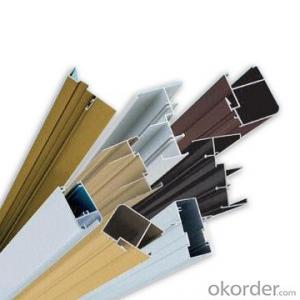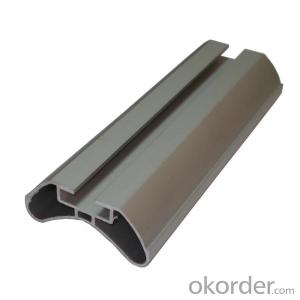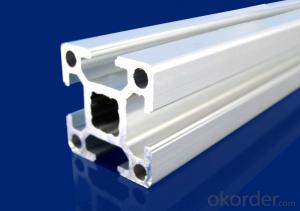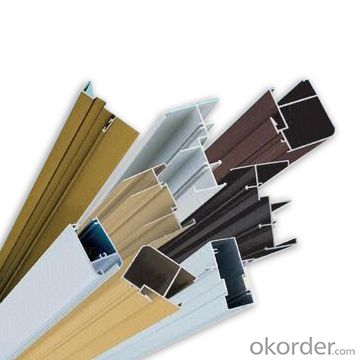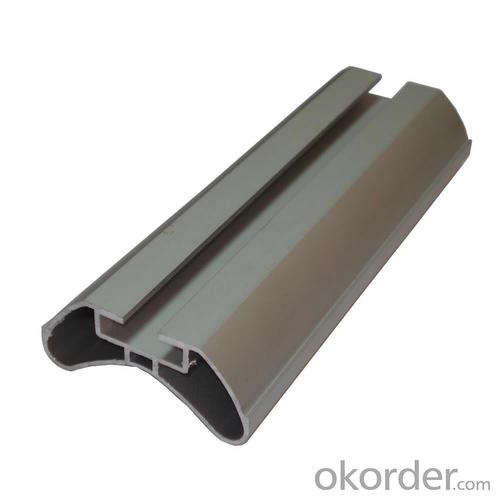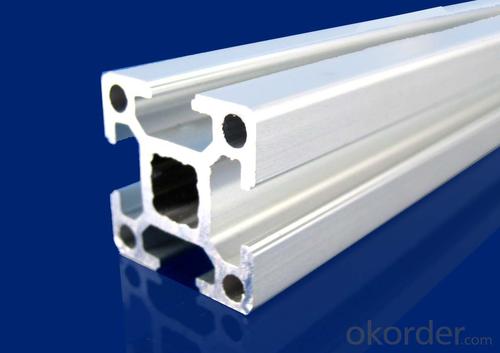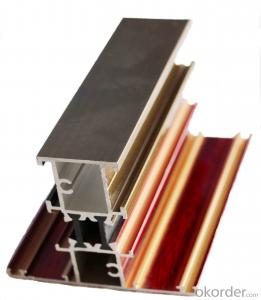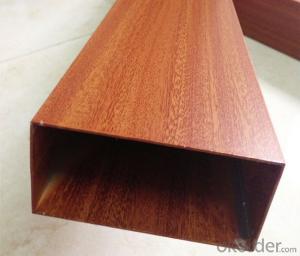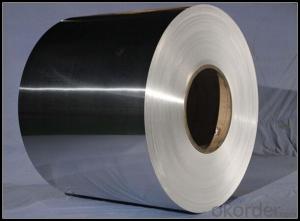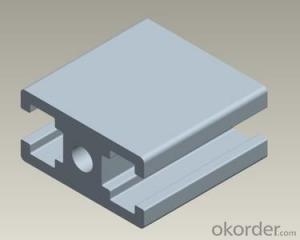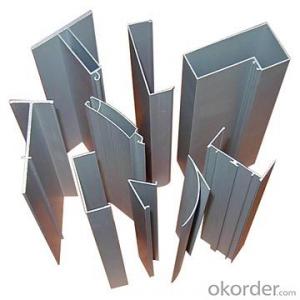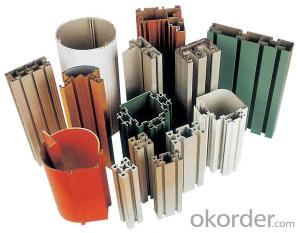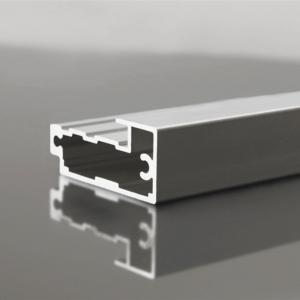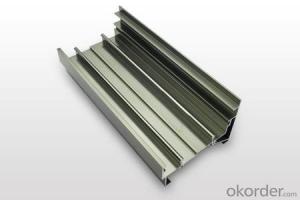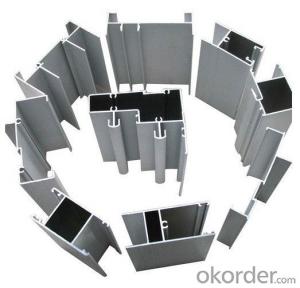Customized 6063 T5 Aluminum Extrusion Profiles H Channel
- Loading Port:
- China Main Port
- Payment Terms:
- TT OR LC
- Min Order Qty:
- -
- Supply Capability:
- -
OKorder Service Pledge
OKorder Financial Service
You Might Also Like
Aluminium is a relatively soft, durable, lightweight, ductileand malleablemetalwith appearance ranging from silvery to dull gray, depending on the surfaceroughness. It is nonmagnetic and does not easily ignite. A fresh film ofaluminium serves as a good reflector (approximately 92%) of visible lightand an excellent reflector (as much as 98%) of medium and far infraredradiation. The yield strength of pure aluminium is 7–11 MPa,while aluminium alloys have yield strengths ranging from200 MPa to 600 MPa. Aluminium has about one-third the densityand stiffness of steel. It is easily machined,cast, drawn and extruded.
Aluminium alloys (or aluminum alloys; see spellingdifferences) are alloysin which aluminium(Al) is the predominant metal. The typical alloying elements are copper, magnesium,manganese,silicon,tin and zinc. There are twoprincipal classifications, namely casting alloys and wrought alloys, both of which are furthersubdivided into the categories heat-treatableand non-heat-treatable. About 85% of aluminium is used for wrought products,for example rolled plate, foils and extrusions.Cast aluminium alloys yield cost-effective products due to the low meltingpoint, although they generally have lower tensile strengthsthan wrought alloys. The most important cast aluminium alloy system is Al–Si,where the high levels of silicon (4.0–13%) contribute to give good castingcharacteristics. Aluminium alloys are widely used in engineering structures andcomponents where light weight or corrosion resistance is required
Features:
Material | Alloy 6063,6061,6005or according to customer’s choice |
Temper | T3, T4, T5, T6 |
Surface | Anodize, electrophoresis, powder coating, PVDF coating, wood grain painting, matted, etc. |
Length | Coating 6.5 meters, Anodizing 6.5 meters, Mill finish 5 meters |
Application | Industrial, electrical equipment(TV set, air conditioner, refrigerator, computer), decoration,construction, transportation |
Custom Made | We can package following with customer's request. |

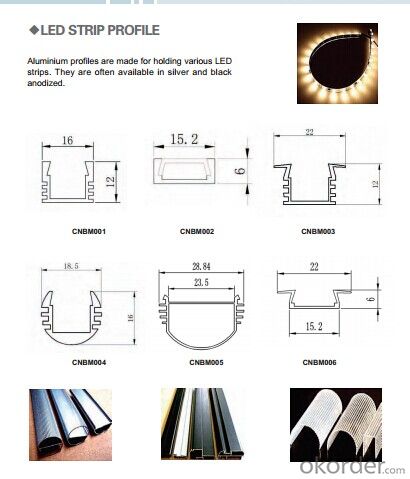
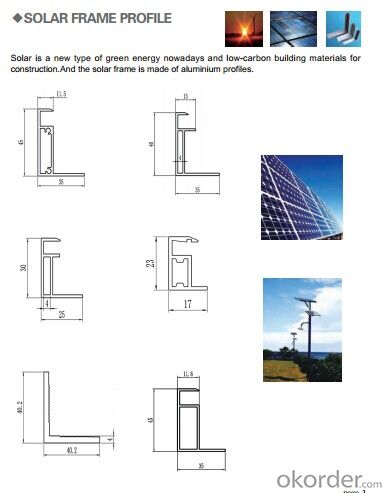
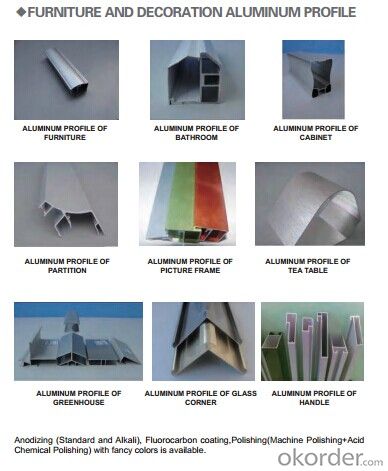
FAQ:
1. What is the form of payment?
Normally 30% TT, L/C at sight
2. Type of quotation?
FOB, CFR, CIF
3. Port of loading?
Shenzhen/Guangzhou port
4. Delivery time?
15-20 days after client’s deposit
- Q: What are the differences between the aluminum profile material and the anodized aluminum profile? Where are they used? If it is necessary to spray the fluorocarbon paint on aluminum, do it on the basis of anodic oxidation or on the aluminum profile material?
- The surface of the material is not oxidized. The oxidized aluminum profile has a smooth and beautiful surface. According to your requirements, choose material
- Q: Is it possible to utilize recycled aluminum products as an alternative to new ones to decrease environmental impact and save costs?
- <p>Yes, using recycled aluminum products is an effective way to reduce environmental impact and cost. Recycling aluminum requires significantly less energy compared to producing new aluminum from raw materials, which reduces greenhouse gas emissions. Additionally, recycled aluminum retains the same properties as new aluminum, making it a viable alternative for many applications. This practice not only conserves resources but also lowers production costs, making it a sustainable choice for both the environment and your budget.</p>
- Q: What are the various energy-saving characteristics that can be incorporated into aluminum profiles?
- <p>Aluminum profiles can incorporate several energy-saving features to enhance thermal insulation and reduce energy consumption. These include: 1. Thermal breaks: Inserts that reduce heat transfer between the interior and exterior of a profile. 2. Multi-chamber designs: Multiple air chambers within the profile that act as insulators. 3. Low-E coatings: Reflective coatings that reduce heat transfer. 4. Insulating glass units: Double or triple glazed units with gas fills that provide superior insulation. 5. Passive solar design: Profiles designed to maximize heat gain in winter and minimize it in summer. 6. High-performance seals: Gaskets and seals that minimize air infiltration. 7. Aerodynamic shapes: Profiles that reduce air resistance and heat loss. These features can significantly contribute to energy efficiency in buildings.</p>
- Q: Do aluminum profiles require regular maintenance?
- Maintenance is necessary for aluminum profiles. However, the frequency and extent of maintenance depends on how they are used and the environment they are in. Although aluminum profiles are known for being durable and resistant to corrosion, they can still become dirty, grimy, and oxidized over time. To keep them clean and looking good, it is recommended to regularly clean them with mild soap or detergent and water. It is also a good idea to lubricate any moving parts, like hinges or sliding mechanisms, to ensure they operate smoothly. Additionally, it is important to inspect the profiles for any signs of damage, such as cracks or loose connections, so that any issues can be addressed before they get worse. By doing regular maintenance, the lifespan of aluminum profiles can be extended and their performance can be optimized.
- Q: What are the advantages of using aluminum profiles in the defense industry?
- There are several advantages of using aluminum profiles in the defense industry. Firstly, aluminum profiles offer a high strength-to-weight ratio. This means that they can provide the necessary strength and durability while being lightweight. This is particularly crucial in the defense industry where weight reduction is essential for enhancing mobility and reducing fuel consumption. Secondly, aluminum profiles have excellent corrosion resistance properties. This is particularly advantageous in defense applications where equipment is exposed to harsh environments, such as saltwater or extreme weather conditions. The corrosion resistance of aluminum profiles ensures that the equipment remains functional and reliable for extended periods, reducing maintenance requirements and increasing the overall lifespan of the components. Furthermore, aluminum profiles are highly malleable and can be easily fabricated into complex shapes and designs. This versatility allows for greater design flexibility in defense applications, enabling the creation of intricate and tailored components. Additionally, aluminum profiles can be easily joined with other materials, such as composites or steel, further expanding their potential applications in the defense industry. Another advantage of aluminum profiles is their excellent thermal conductivity. Aluminum has a high thermal conductivity compared to other metals, allowing for efficient heat dissipation in defense equipment. This is particularly important in applications where thermal management is critical, such as electronic systems or high-performance vehicles. The ability of aluminum profiles to dissipate heat effectively ensures the reliability and longevity of sensitive components. Lastly, aluminum is a widely available and cost-effective material. It is abundant in nature and can be easily extracted, making it readily accessible for defense manufacturing. Moreover, its low cost compared to other metals such as titanium or steel makes it an economical choice for defense applications, allowing for cost-effective production of large quantities of components without compromising on quality or performance. In conclusion, the advantages of using aluminum profiles in the defense industry include their high strength-to-weight ratio, corrosion resistance, versatility in fabrication, excellent thermal conductivity, and cost-effectiveness. These characteristics make aluminum profiles an ideal choice for a wide range of defense applications, contributing to enhanced performance, durability, and cost-efficiency in this critical sector.
- Q: What are the weight limitations of aluminum profiles?
- The weight limitations of aluminum profiles vary depending on their dimensions, thickness, and overall structural design. However, in general, aluminum profiles can support significant loads due to the strength and durability of the material. It is best to consult with the manufacturer or engineer to determine the specific weight limitations based on the intended application and structural requirements.
- Q: the middle of the following is a groove structure, as if you can not bolt hole, then how to install the rail on it? What's the use of flat sealing strips and slip bars embedded inside? Is it necessary to mount the guide rail on the aluminum profile, you can choose more than 6060 of the profiles, the middle is flat structure, and then drill holes in the bolt connection rail Thanks
- Use the T nut (in the T groove) to fit the rail, the flat sealing strip, and the slip bar embedded in it for dust, waterproof, oil proof and so on.Guide (TTW): metal or other materials made of grooves or ridges, can withstand, fixed, and guide the movement of devices or equipment, and reduce its friction of a device.
- Q: Are aluminum profiles suitable for furniture applications?
- Yes, aluminum profiles are suitable for furniture applications. Aluminum is a versatile and lightweight material that offers several advantages for furniture design and construction. Firstly, aluminum profiles provide excellent strength and durability, making them ideal for furniture that needs to withstand regular use and weight-bearing. They are resistant to corrosion, which means they can be used both indoors and outdoors without the risk of rusting or deteriorating over time. Additionally, aluminum profiles offer flexibility in design. They can be easily shaped and formed into various shapes and sizes, allowing for creative and innovative furniture designs. Aluminum profiles can also be extruded into different profiles and sections, enabling customization and adaptability to different furniture styles and requirements. Furthermore, aluminum is a sustainable material that can be recycled repeatedly without losing its properties. This makes it an environmentally friendly choice for furniture applications. Overall, aluminum profiles provide a combination of strength, durability, versatility, and sustainability, making them a suitable choice for various furniture applications.
- Q: What are the different bending radii available for aluminum profiles?
- The bending radii available for aluminum profiles can vary depending on the specific requirements of the application. However, aluminum profiles typically come in a range of bending radii options to cater to different needs. Some common bending radii for aluminum profiles include 1.5D, 2D, 3D, and 4D. The "D" in these radii refers to the outer diameter of the profile. For example, a 1.5D bending radius means that the radius of the bend is 1.5 times the outer diameter of the profile. The choice of bending radius depends on factors such as the thickness and alloy of the aluminum, the desired bending angle, and the intended application. Smaller bending radii are often used for tighter bends or when a more compact design is required. On the other hand, larger bending radii are suitable for gentler bends or when the structural integrity of the profile needs to be maintained. It is important to note that the bending process can affect the mechanical properties of the aluminum profile, such as its strength and stiffness. Therefore, it is crucial to consider the bending radius carefully to ensure that the profile retains its desired properties after bending. To determine the most suitable bending radius for a specific aluminum profile, it is advisable to consult with manufacturers or experts who have expertise in aluminum bending processes. They can provide guidance based on the specific requirements and limitations of the application.
- Q: How do you ensure proper electrical grounding with aluminum profiles?
- To ensure proper electrical grounding with aluminum profiles, there are a few key steps that need to be followed. Firstly, it is important to ensure that all aluminum profiles are clean and free from any dirt, dust, or oxidation. This can be achieved by using a suitable cleaning agent or solvent to remove any contaminants that may hinder the grounding process. Next, proper electrical grounding can be achieved by using conductive hardware such as grounding clips or brackets specifically designed for aluminum profiles. These hardware components should be securely attached to the aluminum profiles, ensuring a reliable electrical connection. Additionally, it is crucial to establish a solid electrical connection between the aluminum profiles and the grounding system. This can be achieved by using copper or aluminum grounding conductors that are properly sized and securely connected to both the aluminum profiles and the grounding system. Furthermore, it is important to regularly inspect the grounding system to ensure its effectiveness. This can involve checking for any loose connections, signs of corrosion, or damage to the grounding conductors. Any issues should be promptly addressed and repaired to maintain proper electrical grounding. Lastly, it is recommended to consult with a qualified electrician or engineer who specializes in electrical grounding when working with aluminum profiles. They can provide specific guidance and ensure compliance with relevant electrical codes and standards to ensure proper and safe electrical grounding.
Send your message to us
Customized 6063 T5 Aluminum Extrusion Profiles H Channel
- Loading Port:
- China Main Port
- Payment Terms:
- TT OR LC
- Min Order Qty:
- -
- Supply Capability:
- -
OKorder Service Pledge
OKorder Financial Service
Similar products
Hot products
Hot Searches
Related keywords
